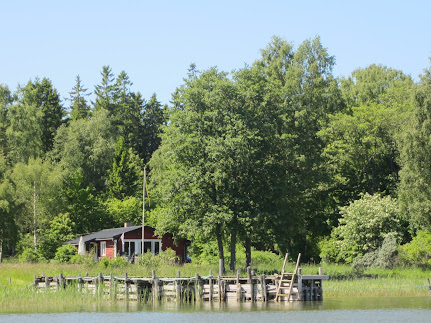I have come across a rather interesting map of the Stockholm Archipelago, made by Carl Gripenhielms around 1690. As you might expect, it is wildly inaccurate, especially for those parts of the archipelago that were not heavily populated, but for the area I know well there are some fascinating details. For a start, the northern part of the island of Blidö, which is called Oxhalsö (island of the oxens throat) was at that time an island surrounded by sea water. Note that Oxhalsö is spelt Oxhals Öhn.........
Given that the orientation of the old map is about 45 degrees away from the modern standard orientation, with north at the top, it's possible to compare the old map with the modern one. The area where we have our cottage was mostly under water in 1690, since relative sea level was then about 2.2m higher than it is today. It's all to do with isostatic recovery since the end of the last glacial episode...........
The area around Bromskär was an island, with quite a wide stretch of water between it and the mainland. The peninsula of Granören was also an island, with a curving channel running round it and out to the modern coast near Rådmansholmen. This is currently a boggy area where there was a plan, some years ago, for the excavation of a canal to allow clean water to enter the bay where we currently keep the family boats. The island which we currently call Granöören (fir tree island island) is shown clearly, much further out.
The small island which we call Alören is shown with a name difficult to decipher -- it could be "Starbatsdyret" or something similar. Could it be something to do with navigation -- with an old word for "starboard"?? There is a speckled area close to it, labelled "Blötingsön" or similar. "Blöt" is the word for damp -- so this could be an area of shoals or grounds more or less where the members of my wife's family currently have their plots and their cottages.......
Anyway, nearly all of the land which makes up our summer paradise was, in 1690, under water. And what a difference a 2m sea level rise (or fall) has on coastal topography in lowland areas, even in an area like this, where there are no high tides or storm surges........ Please note -- the experts are now talking about a 2m rise of global sea level associated with ice sheet collapse.........







No comments:
Post a Comment
Please leave your message here